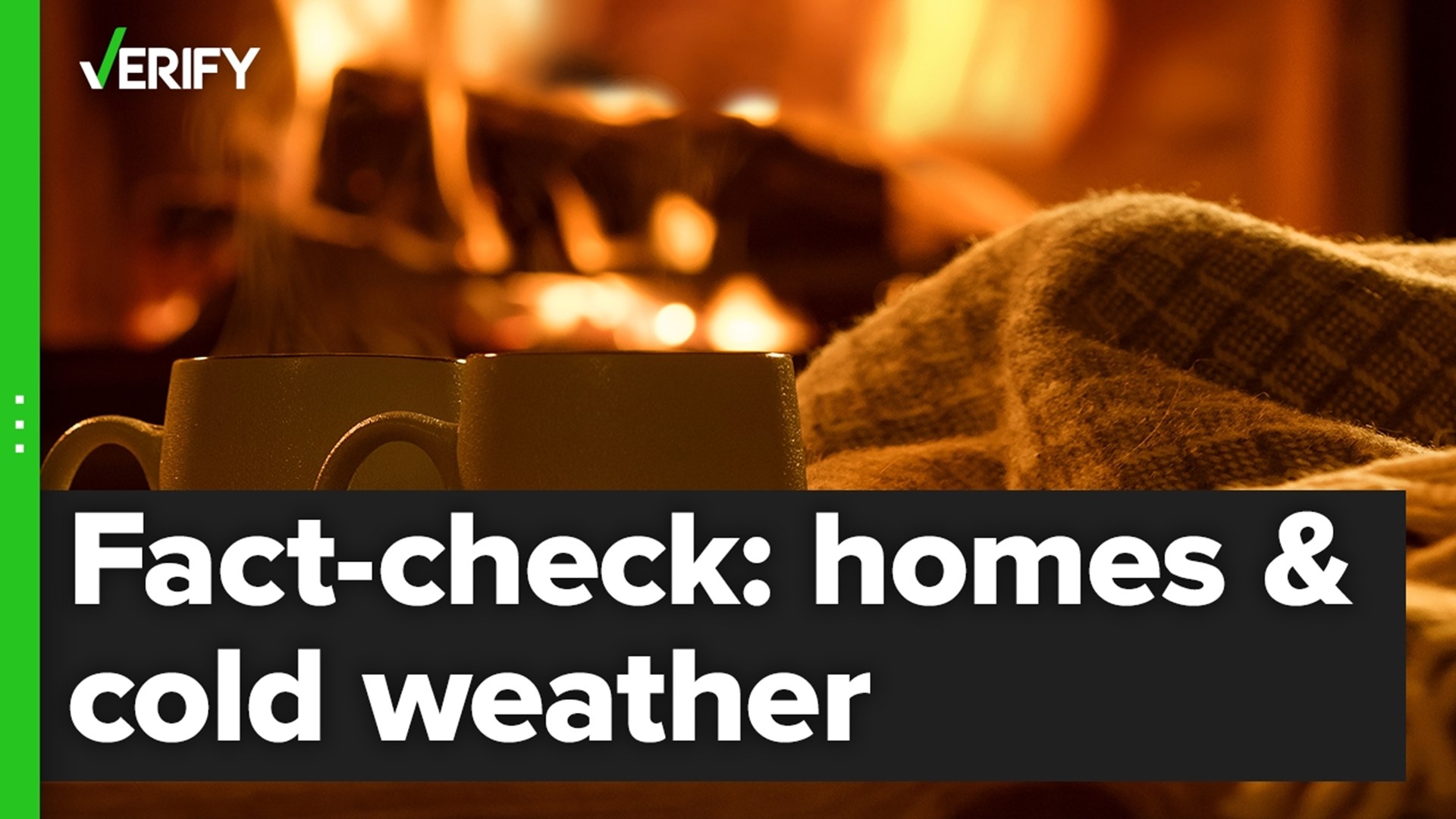Cold weather has officially arrived, bringing below-freezing temperatures to many areas of the U.S.
Many VERIFY readers have asked the team to look into ways to stay warm and protect their homes from cold weather. We looked into five common claims.
THE SOURCES
- American Red Cross
- Mississippi State University
- J. Blanton Plumbing, a plumbing company based in Illinois
- Millwood Plumbing, a plumbing company based in Georgia
- Home Depot
- ENERGY Star, the federal government’s energy efficiency program
- The U.S. Department of Energy
- Glen Dimplex, an HVAC manufacturer
- StatGuardPlus, a thermostat security company
- Apollo Home, an HVAC company based in Cincinnati, Ohio
- Prime Energy, a renewable energy company based in New England
QUESTION #1
Can leaving faucets dripping prevent pipes from bursting in freezing weather?
THE ANSWER
When temperatures drop, the water in your pipes can freeze and lead to a burst pipe. But you can help prevent this from happening by allowing water to drip from your faucets, experts say.
There's always water in your pipes, even if the faucet isn't turned on. Standing water freezes more quickly than running water, say Chicago-area J. Blanton Plumbing and Georgia-based Millwood Plumbing. So when you set your faucets to a drip, the water in your pipes begins to move just enough to keep it from freezing as easily as it would when turned off.
You should let cold water drip rather than warm water, since your cold water supply is far more likely to freeze. Additionally, if you know the location of the faucet farthest from your main water supply, you should drip that one. That faucet will get water moving all the way through your home.
Researchers say a "typical freezing event" in home water pipes happens at around 20 degrees Fahrenheit. But to be on the safe side, you should consider dripping your faucets if temperatures are below freezing — 32 degrees Fahrenheit or less. Mississippi State University recommends that you continue to leave your faucets dripping until the temperature is consistently above freezing once again.
There are other ways to prevent frozen pipes, too, such as insulating them.
More from VERIFY: Yes, leaving faucets dripping during freezing weather can help prevent pipes from bursting
QUESTION #2
Does spinning a ceiling fan in a clockwise direction make your room feel warmer?
THE ANSWER
In the winter, your ceiling fan should spin clockwise at a low speed, according to Home Depot and ENERGY STAR.
“This produces a gentle updraft, which forces warm air near the ceiling down into the occupied space,” ENERGY Star, the federal government’s energy efficiency program, says.
Your ceiling fan spinning clockwise will make the room feel warmer, allowing you to lower the thermostat and save money on energy costs. This tip is especially important for people with high ceilings, Home Depot says.
QUESTION #3
Will closing your curtains at night and opening them during the day help keep your home warm?
THE ANSWER
One-third of the heat in an average home is lost through the windows, the U.S. Department of Energy (DOE) estimates.
But you can prevent some of that heat loss by closing all drapes at night, as well as closing those that don’t receive sunlight during the day. This can help keep up to 10% more heat inside your home, lowering your energy bill, according to the DOE.
The DOE also recommends opening window coverings in the morning so the sun can heat your home throughout the day. This is especially important for windows that receive direct sunlight.
Home Depot also has more tips on how to insulate your windows in the winter to prevent heat loss, including the use of caulking, window insulation film, weather stripping and draft stoppers.
MORE FROM VERIFY: Yes, electric vehicles lose range in cold weather
QUESTION #4
Will cranking the thermostat way up heat your home faster?
THE ANSWER
Many people believe turning their thermostat higher than their desired temperature will heat their home quicker. But that’s not the case.
Furnaces have just two settings: on and off. They rely on a thermostat to know how long to stay on.
Cranking up the thermostat will only make your heating system run longer to get your room to the higher set temperature, and it won’t heat your home any faster, experts say.
To save energy in the winter, the Department of Energy recommends setting your thermostat to around 68 degrees while you’re awake and setting it lower while you’re asleep or away from your home.
QUESTION #5
Is completely closing vents in unused rooms a reliable way to save money on heating?
THE ANSWER
VERIFY found that completely closing vents in unused rooms isn’t a reliable way to save money.
Your HVAC system is designed to heat and cool your entire home, and attempting to force it to heat just part of your home risks damaging it and hurting its efficiency. You also run the risk of increasing your heating costs by completely closing vents.
Partially closing your vents, however, may save you a little money without the risks.
You can partially close the one or two vents furthest away from your furnace to save a little money while keeping enough air flow moving through the system to keep it running properly so it doesn’t cost you more down the line, Apollo Home says.
The ideal position for your vents is about 50-74% of the way closed, according to Prime Energy, a New England renewable energy company.
More from VERIFY: No, completely closing vents isn’t a reliable way to save money on central heating

